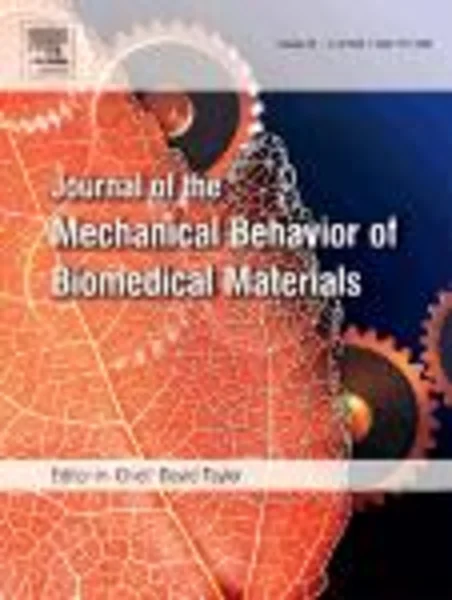-
the effect of cyclic hydrostatic pressure on the functional development of cartilaginous tissues engineered using bone marrow derived mesenchymal stem cells
جزئیات بیشتر مقاله- تاریخ ارائه: 1394/01/01
- تاریخ انتشار در تی پی بین: 1394/01/01
- تعداد بازدید: 860
- تعداد پرسش و پاسخ ها: 0
- شماره تماس دبیرخانه رویداد: -
mechanical signals can play a key role in regulating the chondrogenic differentiation of mesenchymal stem cells (mscs). the objective of this study was to determine if the long-term application of cyclic hydrostatic pressure could be used to improve the functional properties of cartilaginous tissues engineered using bone marrow derived mscs. mscs were isolated from the femora of two porcine donors, expanded separately under identical conditions, and then suspended in cylindrical agarose hydrogels. constructs from both donors were maintained in a chemically defined media supplemented with tgf-β3 for 42 days. tgf-β3 was removed from a subset of constructs from day 21 to 42. loaded groups were subjected to 10 mpa of cyclic hydrostatic pressurisation at 1 hz for one hour/day, five days/week. loading consisted either of continuous hydrostatic pressure (chp) initiated at day 0, or delayed hydrostatic pressure (dhp) initiated at day 21. free swelling (fs) constructs were cultured in parallel as controls. constructs were assessed at days 0, 21 and 42. mscs isolated from both donors were morphologically similar, demonstrated comparable colony forming unit-fibroblast (cfu-f) numbers, and accumulated near identical levels of collagen and gag following 42 days of free swelling culture. somewhat unexpectedly the two donors displayed a differential response to hydrostatic pressure. for one donor the application of chp resulted in increased collagen and gag accumulation by day 42, resulting in an increased dynamic modulus compared to fs controls. in contrast, chp had no effect on matrix accumulation for the other donor. the application of dhp had no effect on either matrix accumulation or construct mechanical properties for both donors. variability in the response to hydrostatic pressure was also observed for three further donors. in conclusion, this study demonstrates that the application of long-term hydrostatic pressure can be used to improve the functional properties of cartilaginous tissues engineered using bone marrow derived mscs by enhancing collagen and gag accumulation. the response to such loading however is donor dependent, which has implications for the clinical utilisation of such a stimulus when engineering cartilaginous grafts using autologous mscs.
مقالات جدیدترین رویدادها
-
استفاده از تحلیل اهمیت-عملکرد در ارائه الگوی مدیریت خلاقیت سازمانی و ارائه راهکار جهت بهبود
-
بررسی تاثیر ارزش وجوه نقد مازاد بر ساختار سرمایه شرکت های پذیرفته شده در بورس اوراق بهادار تهران
-
بررسی تأثیر سطح افشای ریسک بر قرارداد بدهی شرکت های پذیرفته شده در بورس اوراق بهادار تهران
-
بررسی تأثیر رتبه بندی اعتباری مبتنی بر مدل امتیاز بازار نوظهور بر نقد شوندگی سهام با تأکید بر خصوصی سازی شرکت ها
-
تأثیر آمیخته بازاریابی پوشاک ایرانی بر تصویر ذهنی مشتری پوشاک ایرانی (هاکوپیان)
-
بررسی نقش ادراک محیطی بر رضایتمندی و انتخاب اولویت های سکونتی
-
مروری بر عفونت های بیمارستانی و ارائه راهکارهایی برای پیشگیری و کنترل آنها
-
چگونگی کاربرد تست های غربالگری ارتولانی و بارلو جهت تشخیص دررفتگی دیسپلاستیک هیپ نوزادان
-
تهیه، تخلیص و شناسایی اجزاء آنتی ژن های دفعی- ترشحی تاکی زوئیت های توکسوپلاسماگوندی سویه rh
-
water chemistry of a combined-cycle power plant’s auxiliary equipment cooling system
مقالات جدیدترین ژورنال ها
-
مدیریت و بررسی افسردگی دانش آموزان دختر مقطع متوسطه دوم در دروان کرونا در شهرستان دزفول
-
مدیریت و بررسی خرد سیاسی در اندیشه ی فردوسی در ادب ایران
-
واکاوی و مدیریت توصیفی قلمدان(جاکلیدی)ضریح در موزه آستان قدس رضوی
-
بررسی تاثیر خلاقیت، دانش و انگیزه کارکنان بر پیشنهادات نوآورانه کارکنان ( مورد مطالعه: هتل های 3 و 4 ستاره استان کرمان)
-
بررسی تاثیر کیفیت سیستم های اطلاعاتی بر تصمیم گیری موفق در شرکتهای تولیدی استان اصفهان (مورد مطالعه: مدیران شرکتهای تولیدی استان اصفهان)
-
تعمق و تأملی بر نظریه و مکتب هنری کلاسیسیسم و تأثیرات آن بر معماری و موسیقی
-
بررسی رابطه بین پاداش نقدی و عملکرد بانک با تاکید بر نقش مدیریت سود
-
بررسی نقش عوامل زمینه ای در عناصر سیستم مدیریت ایمنی، بهداشت، محیط زیست در کارکنان شبکه بهداشت و درمان شهرستان ابرکوه
-
چارچوب مدیریتی اجرایی برای پایگاه داده های فازی
-
الگوی ساختاری موفقیت تحصیلی بر اساس اعتماد به نفس و سرمایه های روانشناختی با میانجی گری راهبرد های مقابله ای (اجتنابی ، مسئله مدار و هیجان مدار )




سوال خود را در مورد این مقاله مطرح نمایید :